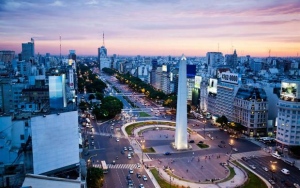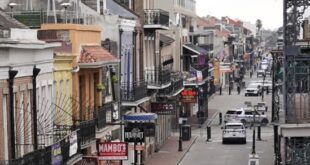
BUENOS AIRES, Argentina
During Buenos Aires’ heyday, fabulous wealth flowed into the city from Argentina’s agricultural heartland, turning the country into one of the world’s richest by the early 20th century. The evidence of that era is still apparent in the grand architectural showpieces scattered around this sprawling city of three million.
But since the late 1940s, Argentina has experienced dictatorship, military rule, corruption and a succession of crippling economic crises. Artless graffiti scars nearly every building and much of the transit system, though efficient, hasn’t been updated since the 1960s.
Still, it remains a marvelous destination. Meet a few Portenos, as city residents are called, and take advantage of the legendary nightlife and restaurant scene, and you’ll get a buzz from the culture that invented the tango.
No trip to Buenos Aires would be complete without a swing past the blushing balconies of La Casa Rosada, or Pink House, where Eva Peron and her president husband Juan once addressed adoring crowds. The building faces Plaza de Mayo, the heart of the city that provides a good jumping-off point for exploring the downtown. An organization of mothers of the 30,000 Argentines who disappeared during the dictatorship in the 1970s and ’80s still gathers there, as they have every Thursday for decades.
Continuing the requisite Evita pilgrimage, head up the hill to the posh Recoleta neighbourhood and its namesake cemetery, where the city’s elite have been laid to rest for generations.
The necropolis resembles a city in miniature more than a burial ground, with intricate gothic temples to the dead lined up like rowhouses along a network of stone-paved alleys.
Evita’s black granite gravesite is rather dull by comparison, and generally crowded, but parts of the cemetery offer plenty of opportunities for reflective solitude.
Afterward, stroll around the surrounding area, where the wealthy built palatial homes as they fled a yellow-fever epidemic in the low-lying San Telmo neighbourhood near the Plata River.
What’s new
It wasn’t long ago that the dining scene mostly consisted of steak, empanadas, Italian and more steak. But a flurry of restaurant openings has transformed the city into a worldly food destination. The craft-beer craze arrived along with a burger invasion a few years back, but chefs have begun to draw on other cultures to spice up the mix. The Korean-Argentinian restaurant Kyopo in Flores serves a sweet and spicy kimchi burger as well as savoury rice bowls. In Villa Crespo, I Latina serves seafood-focused tasting menu of Colombian fare in a renovated townhouse.
The Pope Francis story has become big business in his native city. A number of tours have popped up to show off the sites he used to frequent when he was known as Jorge Mario Bergoglio. Stops include where he grew up in Flores, his former schools and the Metropolitan Cathedral where he presided.
Hanging out
San Telmo, one of the city’s oldest neighbourhoods, today is an artsy enclave known for a Sunday-afternoon market at Plaza Dorrego with hundreds of stalls selling antiques, leather goods, vintage gear and handmade accessories.
The rest of the week, sidewalk cafés fan out from the plaza during the day, and late at night (some bars don’t even open until midnight), a bohemian crowd mingles with tourists.
One called Doppelganger serves more than 100 cocktails at its dimly lit mahogany bar.
Besides late nights, Buenos Aires is also known for its beef. Don Julio and La Cabrera in the Palermo neighbourhood represent fine options at the top end of the steak-joint spectrum, particularly if you pair the meal with a bold Malbec wine.
In the riverside Puerto Madera area, La Cabana sources its beef from its own ranch and offers views of the spire that angles up from a pedestrian bridge by architect Santiago Calatrava, who designed the Oculus transportation hub at One World Trade in New York.
Tips
Find a way to experience one of Argentina’s signature attractions: the tango.
You’re bound to stumble across dancers performing for tips on the streets, and there are numerous tango shows catering to tourists, including in Café Tortoni downtown and El Viejo Almacen in San Telmo.
But it’s best to hit up a milonga, which is essentially a tango gathering. Usually lessons are offered before a milonga begins.
I found one in Villa Crespo at a downmarket sports club called Villa Malcolm.
A two-hour group lesson in the pink and blue room cost only 60 pesos on a Monday night (about $5.25 Cdn).
The vast transit system can be baffling, but rides cost only 7.5 pesos (65 cents Cdn), and its six lines mostly lead downtown.
Palermo Soho offers a low-key vibe
Once you’ve seen Buenos Aires’ wide, crowded boulevards and the balcony where Eva Peron waved to the masses, you might get the impression the city is all about grandiose architecture and the fast-paced attitude that is so common in big cities.
But head to Palermo Soho, and you’ll notice that the buildings get smaller, the streets get calmer and the crowds get cooler.
Once a rundown warehouse district with shabby stucco homes, the area takes its name from New York’s upscale SoHo neighbourhood.
A canopy of oak trees lines the cobblestone streets, which are more pedestrian- and bike-friendly than in many other neighbourhoods.
Still, be careful crossing the street, because stop signs and crosswalks are but faint suggestions to most drivers.
Palermo is Buenos Aires’ largest neighbourhood, but it can vary greatly from one end to the other and it’s divided into several sections.
Palermo Soho is roughly bordered by the avenues Cordoba, Scalabrini Ortiz, Santa Fe and Juan B. Justo.
From downtown, take the green D line on the subway, known as Subte, to the Plaza Italia station, find Jorge Luis Borges street and walk away from the botanical garden.
After about eight blocks, you’ll run into the oval Plaza Serrano, which sits at the centre of the neighbourhood.
Palermo Soho isn’t exactly undiscovered by tourists, but there aren’t many big hotels and it’s devoid of the city’s most famous historical and cultural attractions.
Instead, you come to this part of town to shop, eat and drink.
After the Argentine peso plummeted in value in 2002, importing clothes became prohibitively expensive.
As a result, young local designers filled the void and opened up shop here.
At Agostina Bianchi, located at Thames 1733, you’ll find limited-edition handmade clothing for women that seems to fuse knitting with high fashion.
For men, try Felix, at Honduras 4916, for a wide selection of local brands in styles ranging from tank tops to suits. Gurruchaga street around the corner is packed with trendy boutiques, and during the weekends, Plaza Serrano and nearby Plaza Armenia transform into a funky arts and crafts fair.
For dinner, Palermo Soho offers a high concentration of quality restaurants.
The supper-clubby Casa Cruz, at Uriarte 1658, sits behind 4.5-metre brass doors and blends updated Argentine standards with Mediterranean flavours.
The seafood-focused Crizia, at Gorriti 5143, provides a welcome break from all the beef joints in a soaring converted warehouse. Skip dessert and instead hit up one of the area’s numerous ice cream shops.
Try dulce de leche, an Argentine specialty, at Tufic, at Guatemala 4597.
Several bars that seem to cater to a get-drunk crowd form a ring around Plaza Serrano, where young people taking advantage of two-for-one drink specials hang out late into the night strumming guitars.
But you can fan out from the plaza for a more sophisticated side. Nicky Harrison, at Malabia 1764, is tucked into the back of a stellar sushi restaurant and serves creative drinks such as the Valkiria, a combo of vodka, absinthe, honey and lime juice.
[ad_2]You can read more of the news on source
 Travelsmart
Travelsmart



